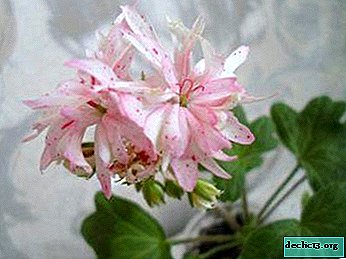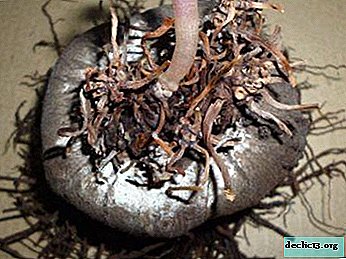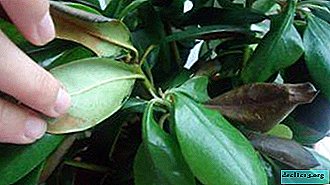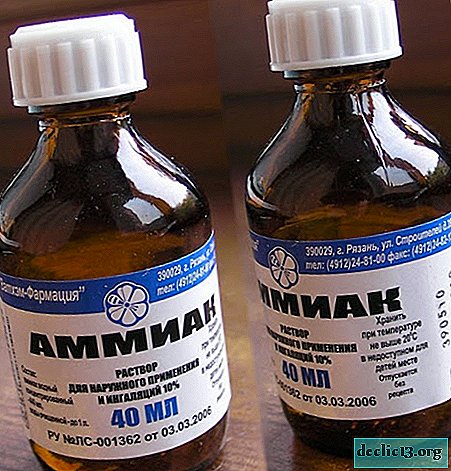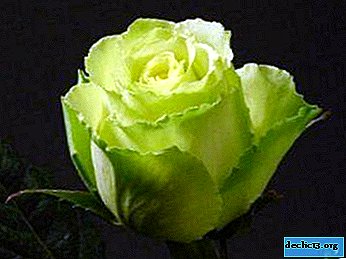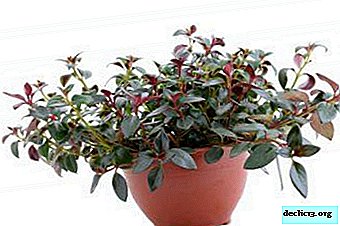Unusually beautiful roses Blash: description and photo of the variety, use in landscape design, care and other nuances
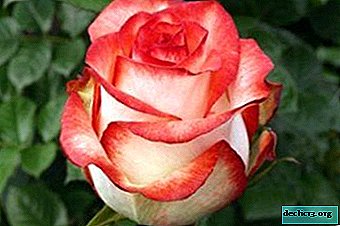
Blush is a rare variety of tea-hybrid roses. The plant is characterized by unusually beautiful flowering, which fascinates with the play of colors.
The blush tolerates heat and frost well. With proper care, it blooms profusely and continuously.
You will learn more about this rose from the article, see how it looks in the photo. Find out how the Rose Blush differs from other species, how to care for it.
Detailed description and photo varieties
Rose Blush is also called Blush rose, which means "rosy rose". In the description of the variety, other names are found: Doom, Blanche, Bush. A blush is a perennial shrub that grows to a height of 120 cm and a width of 80 cm. The foliage is large, dark green, slightly glossy. The stems are almost devoid of thorns.
The resulting buds are tall and dense, have the correct goblet shape and raspberry pink color. As they bloom, the petals burn out to a milky cream, retaining a bright color only along the edges. Blooming flowers are terry, large, up to 12 cm in diameter. They are located on the stem one at a time.
The aroma of roses is pleasant, light and unobtrusive. Blush rose is a hybrid tea variety. It is characterized by medium resistance to rain.Grade Advantages:
- Two-tone rose.
- The flowers on the bush hold their shape for a long time.
- Suitable for garden design, and for cultivation for cutting.
- Cut buds open slowly and do not lose freshness for a long time.
- High winter hardiness.
- Rose is resistant to drought.
disadvantages:
- Medium disease resistance.
- In the first years after planting, the bush can slowly develop and grow the root system for a long time. Abundant flowering is observed only 2-3 years after planting.
Further on the photo you can see how the Rose Blash looks.





History of occurrence
The variety was created by American breeders in 2007.
What is the difference from the rest of the species?
As the bud opens, the petals change their color.
Bloom
- When and how? Flowering is plentiful and continuous. Rose blooms from May to the very frosts.
- Care before and after flowering - features. Before flowering, Blush is fed with nitrogen fertilizers, and after flowering - phosphorus-potash. Faded buds are removed from the bush.
- What to do if it does not bloom? If the bush does not bloom, the conditions of detention are most likely violated. It is necessary to analyze them and identify errors. In order for Blash to please regular and long flowering, you need to take good care of it:
- timely pruning;
- water correctly;
- provide protection against drafts;
- organize complete feeding.
Use in landscape design
Blush can be a spectacular decoration of the flower garden or used as part of a mixborder. It looks great both in single and in group plantings. A suitable background for a blush is a regular green lawn. To create a harmonious composition, Blush is combined with white or yellow roses.
Step-by-step care instructions
Seat selection
 Blush prefers sunny areas, but normally tolerates partial shade. It is recommended to place the rose in a place that is lit by the sun from morning to evening. It is in such conditions that the decorative properties of this plant are maximally manifested. The Blash site should be protected from winds and drafts, but with adequate air circulation.
Blush prefers sunny areas, but normally tolerates partial shade. It is recommended to place the rose in a place that is lit by the sun from morning to evening. It is in such conditions that the decorative properties of this plant are maximally manifested. The Blash site should be protected from winds and drafts, but with adequate air circulation.
Cannot be chosen for landing Blush lowlands. Otherwise, the rose may become sick due to the cool air that lingers in such places.
It is necessary to maintain a distance of at least 1-2 m from shrubs and from 3 m from trees. If this rule is not observed, the roots of the trees will take moisture from the seedlings, and the crown will create a shadow.Timing
Roses are planted in spring, after the end of frost, or in autumn, before the onset of frost.
What should be the soil?
For the successful development of a rose, it is important to plant it in a suitable soil. The ideal option is loose, loamy or loamy, slightly acidic soil with a pH of 5-6, containing a lot of humus.
Sandy soils are completely unsuitable for this variety.. Such soil is poor, poorly retains moisture, quickly overheats in the heat and is supercooled in winter.
Landing
It is not recommended to plant a rose with seeds. This method does not preserve the varietal qualities of plants. When growing use seedlings. They can be purchased at specialized stores or from trusted people.
You need to choose planting material very carefully. A good seedling has a multi-level root system, an even root neck and a healthy aerial part without dry and rotten areas. Seedlings are bought at the end of March or in April and kept before planting in a cool room. On the eve of landing, they are placed in water for 4-6 hours.
Landing sequence:
 If the soil is sandy, add weathered clay or peat, as well as compost or turf soil.
If the soil is sandy, add weathered clay or peat, as well as compost or turf soil.- Dig holes 40-50 cm deep at a distance of 0.5 m from each other.
- Dip the roots in the talker: 1 part water, 2 parts clay, 1 part manure.
- Place the root system of the plant in the prepared hole, spread the roots.
- To fill up with the earth.
- Seal the soil around the seedling.
- Form a roller from the ground around the bush to hold water at the roots during irrigation.
Temperature
The optimum temperature during the formation of buds and flowering should be in the range from +14 to +20 ºС. In winter, Blush is able to withstand frosts of -20 ºС.
Important! In the first year after planting, the rose is very susceptible to temperature fluctuations. To protect the buds, it is advisable to occult the plant by 15 cm. In summer, in extreme heat, it is recommended to protect the seedlings from direct sunlight using lutrasil.Watering
In the warm season, bushes are watered 2-3 times a week. For one plant, 1 bucket of water is required, and in the heat - 2 buckets. Moisture should penetrate up to 30-35 cm in depth.
Top dressing
Apply special complex mineral fertilizers. In the spring, during the growth of the rose, the first nitrogen fertilizing is applied to the soil, the second - potash. At the time of budding and after flowering, the soil also needs to be fertilized.
In summer, alternate mineral and organic top dressing. In the fall, phosphorus-potassium fertilizers are used.
Weeding
Regularly remove weeds around the plant.
Pruning
If there is a desire to grow a spreading bush on the site, the forming pruning is allowed to be neglected. Sanitary pruning must not be skipped. In spring, as soon as the buds begin to swell, it is necessary to prune old, diseased and non-overwintered shoots with pruners.
Transfer
The blush is transplanted by transshipment.
Preparation for winter
Before persistent frosts, it is recommended to shelter bushes for the winter. Extra branches are deleted. Places of cuts are treated with ash. Flexible stalks are bent to the ground, spud with dry foliage or spruce branches and covered with warming material.
Breeding
 Rose Blush propagated using cuttings. This method makes it possible to maintain varietal qualities. Cuttings are cut from semi-lignified shoots. Harvesting is carried out when the shoots form buds or immediately after flowering.
Rose Blush propagated using cuttings. This method makes it possible to maintain varietal qualities. Cuttings are cut from semi-lignified shoots. Harvesting is carried out when the shoots form buds or immediately after flowering.
- Early in the morning cut shoots from the bush.
- Cuttings 5-8 cm long with 2-3 leaves are cut from the central part. The lower section is made obliquely under the kidney itself, and the upper one 1 cm above the kidney. Remove the bottom sheet and part of the top.
- 18-20 hours before planting, the cuttings are placed in the root formation stimulator, immersing the ends by 1-1.5 cm.
- Cuttings are rinsed with clean water.
- Planted in open ground or in a box. For this, a mixture of vermiculite with sand or sand with peat is poured over sod-humus soil. The substrate layer should be about 3-4 cm. Cuttings are planted obliquely, deepening by 1.5-2 cm.
- Cover with glass or plastic containers or film.
- Moisturize from a spray bottle several times a day.
- After a month, when the roots are formed, the shelter is removed. Cuttings are fed every 2 weeks with a solution of ammonium nitrate or urea (15-20 g per bucket of water).
Diseases and Pests
The blush has medium resistance to fungal diseases. In addition, the leaves or buds of a plant can damage caterpillars, spider mites, aphids, or leafworms. In this case, it is required to immediately remove the affected foliage and treat the rose with special chemical protective equipment, following the instructions on the packaging.
Rosa Blush - an original decoration of a home or garden. Having decided to grow it on your site, it is very important to choose a comfortable place for it, as well as provide a suitable soil composition. If all conditions are met, the magnificent Blush rose flowers will not cease to please the owner for a long time.

 If the soil is sandy, add weathered clay or peat, as well as compost or turf soil.
If the soil is sandy, add weathered clay or peat, as well as compost or turf soil.

